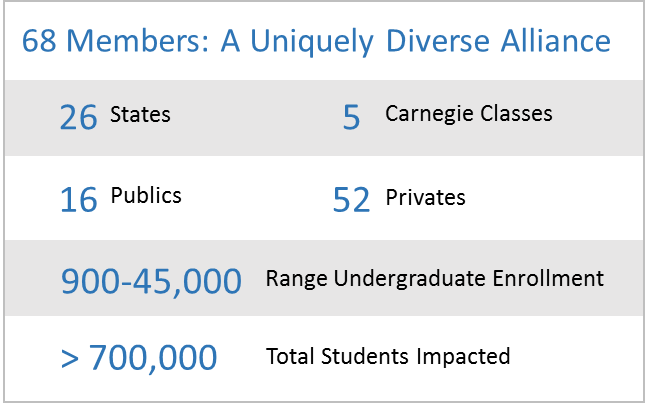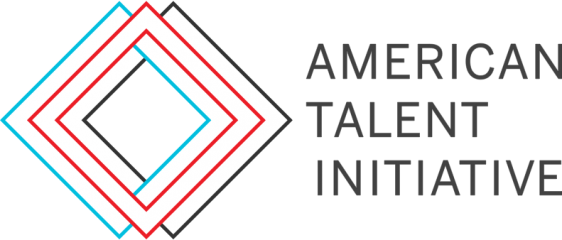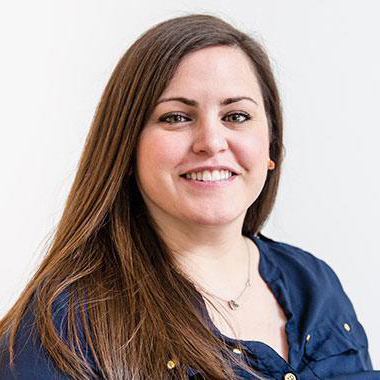Growing the American Talent Initiative: Increasing Access and Opportunity for Lower-Income Students
By Elizabeth Davidson Pisacreta
April 25, 2017
This post originally appeared on the Ithaka S+R blog.
Reading Time: 4 minutes

In December 2016, Ithaka S+R, in collaboration with the Aspen Institute and with support from Bloomberg Philanthropies, launched the American Talent Initiative (ATI), a venture aimed at substantially expanding the number of talented low- and moderate-income students enrolling in and graduating from the colleges and universities with the highest graduation rates. Since its launch, ATI’s mission to increase access and opportunity has resonated with college leaders around the country, and in a few short months, we’ve rapidly expanded ATI membership from 30 to 68 colleges and universities (see full membership list below). As did our founding members, each new member has committed to stepping up their own efforts to increase access and opportunity for our nation’s most talented lower-income students.


Growing ATI membership is necessary to achieve our ambitious goal of attracting, enrolling, and graduating an additional 50,000 high-achieving, lower-income students by 2025. In the coming months, Ithaka S+R will work with colleagues at the Aspen Institute to support member goal-setting, collect data to track individual and collective progress, arrange opportunities for members to share insights and best practices, conduct best-practice research, and coordinate a sustained communications campaign to elevate member successes. Yet, translating ATI’s rapid membership growth into measurable progress towards our ambitious goal will require setting a strong early foundation of collaboration, coordination, and collective responsibility. This strong foundation underpins ATI’s theory of change: collective action and collective responsibility, supported by individual member efforts, will lead to measurable change at our nation’s top colleges.
To build this strong foundation and to cultivate a spirit of collective action and responsibility, we first need to understand individual members’ specific goals and priorities. By joining ATI, each member has endorsed ATI’s collective goal of educating 50,000 additional high-achieving, lower-income students at the 270 colleges and universities with the highest graduation rates by 2025. To translate that endorsement into concrete action, each member college outlines its individual commitments in a goal-setting framework designed by the Ithaka S+R and Aspen teams. Member colleges set goals in one or more of four focus areas:
- Recruiting students from diverse socio-economic backgrounds through robust outreach;
- Ensuring that admitted lower-income students enroll, are included and engaged in the campus community, and are retained through proven effective practices;
- Prioritizing need-based financial aid; and
- Minimizing or eliminating gaps in progression and graduation rates between students from low-, moderate- and high-income families.
Because we have a diverse membership, and we believe that there are many discrete levers that will help us achieve our goal, we purposefully designed a goal-setting framework that allowed for some flexibility in terms of the types of goals that member colleges can set. For example, member colleges that already enroll a large share of Pell recipients may face serious financial constraints to further increasing Pell student enrollment. However, such members can contribute to the collective goal by increasing their Pell student graduation rate, an approach which would increase lower-income student enrollment on their individual campus and thus, contribute to ATI’s collective goal.
Many of the lessons learned in the Ithaka S+R case study series about strategies to improve student success also apply to the approach our members take to completing the ATI goal-setting framework. For instance, the ATI goal-setting framework can serve as a tool to engage campus stakeholders and unite disparate offices in a shared vision for increasing access and opportunity on campus. In completing their goal-setting framework, members shared that the framework brought together key leaders in the offices of admissions and/or enrollment, diversity and inclusion, financial aid, student life and student services, academic affairs, career services, institutional research, communications, advancement and/or development, and others. As the first activity of ATI, we’ve seen that completing the goal-setting framework deepens the institutional commitment by helping member colleges articulate specific, measureable goals and by giving campus leaders a framework and common language to engage the campus community in their efforts to meet those goals.
Perhaps unsurprisingly, members articulated that the goals and priorities outlined in the ATI goal-setting framework often built on existing strategic planning efforts. Interestingly though, members reported that the goal-setting framework encourages college leaders to articulate those existing strategic efforts through the new lens of access and opportunity, which illuminates new challenges and activates innovative on-campus collaborations to help meet those challenges. For instance, one member described how the articulation of their ATI goals strengthened the partnership between the offices of admissions, financial aid, and development. Now, the development office is involved in conversations related to ATI planning and activities so that campus ATI efforts can inform future development campaigns to raise funds for lower-income student scholarships and other supports.
The early lessons learned about members’ diverse approaches to the ATI goal-setting framework provide insight into the possible levers and roadblocks that may advance or impede our collective progress. Moving forward, we, at Ithaka S+R and Aspen, plan to use these insights–in combination with specific member goals and priorities—to inform our planning for future ATI activities, direct our best-practice research, and target member support and resources. As we continue to grow beyond our 68 members, cultivating a spirit of collective action and responsibility amongst a diverse membership will be increasingly important, while at the same time becoming increasingly more difficult. To ensure we meet our ambitious collective goal, we, as the support organizations, will need to continue to think creatively about opportunities and activities that will help our membership translate their individual efforts into collective action.
(*members joining in January–April 2017) |
|
|---|---|
| Allegheny College* | Rice University |
| Amherst College | Rutgers University* |
| Bard College* | Saint Michael’s College* |
| Bates College | Smith College* |
| Baylor University* | Spelman College |
| Brown University* | Stanford University |
| Bucknell University* | Swarthmore College* |
| California Institute of Technology* | The Ohio State University |
| Carleton College* | University of California, Berkeley |
| Claremont McKenna College* | University of California, Davis* |
| Colby College* | University of California, Irvine* |
| Columbia University* | University of California, Los Angeles |
| Cornell University* | University of Denver* |
| Dartmouth College | University of Maryland, College Park |
| Davidson College | University of Massachusetts, Amherst* |
| Dickinson College* | University of Miami* |
| Duke University | University of Michigan - Ann Arbor |
| Elizabethtown College* | University of Minnesota* |
| Fordham University* | University of North Carolina at Chapel Hill |
| Franklin & Marshall College | University of Pennsylvania* |
| Georgetown University | University of Richmond |
| Georgia Institute of Technology | University of South Carolina* |
| Gettysburg College* | University of Southern California* |
| Harvard University | University of Texas at Austin |
| Johns Hopkins University | University of Virginia* |
| Kenyon College* | University of Washington |
| Lafayette College* | Vanderbilt University |
| Lawrence University* | Vassar College |
| Lebanon Valley College* | Wake Forest University* |
| Lehigh University | Washington University in St. Louis |
| Marist College* | Wesleyan University* |
| New York University* | Williams College |
| Pomona College | Wofford College* |
| Princeton University | Yale University |




